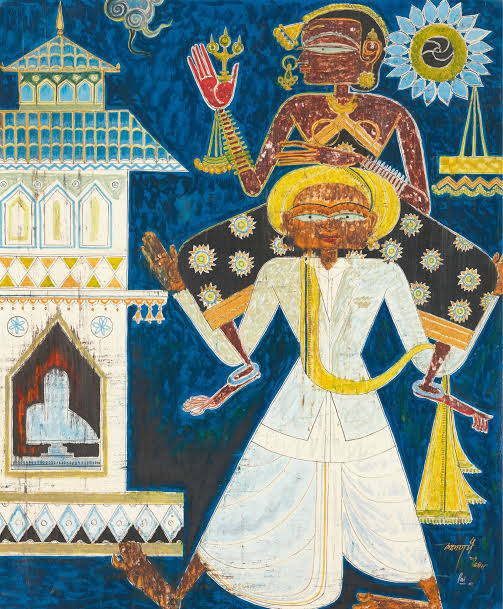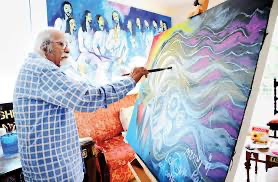The grand old man of Goan art, Laxman Pai, is not with us anymore. Physically. However, the body of work that he has left behind makes us a richer culture.
He passed away on Sunday night. The Padma Bhushan awardee was not just an artists but he also influenced and shaped many people as a teacher. He was a principal of the Goa College of Art, a post he held from 1977 to 1987.

Courtesy: Sothbey’s
A Margao boy, he was born on 21 January 1926. His tryst with art was at his uncle’s Mauzo Photo Studio in Margao, where he used to touch up the black and white photographs with paint. In the 1940s, he was actively involved in the Goa liberation movement for which he was arrested thrice by the Portuguese colonials. He was beaten by the Portuguese police after being arrested and for this reason.
Later, he left for Bombay as Mumbai was known then, where he studied at the Sir J J School of Art from 1943 to 1947. He was awarded the Mayo Medal in 1947.
Pai sat on satyagraha outside the Margao Police Station in 1946, which ensured that he became an important figure in the Goan cultural firmament.
Pai always seemed to be natural teacher. After passing out from J J School of Art, he became a teacher there. At the same time, he participated in the activities of the Bombay Progressive Artists\’ Group, although he did not become its member. Pai recalls that once, a nude painting by Francis Newton Souza was objected to by the then Chief Minister of Bombay State, Morarji Desai. Due to Pai’s association with Souza, he was demoted. Pai wrote a letter about it to the J J School of Art but was told to drop his accusations against the Director. He declined to do so and was expelled as a result.
Subsequently, he wrote to S H Raza who was then in Paris. Raza made arrangements for Pai’s arrival in Paris. Pai went to Paris and studied fresco and etching there. He studied at the prestigious École des Beaux-Arts and stayed in Paris for ten years. During his stay in Paris, Pai held ten solo exhibitions in the city.
He had to his credit more than 110 one-man shows across the globe.
Pai was inspired by Indian miniatures from 1947 to 1950 and painted Goan subjects in that idiom. His initial works speak about the Goan way of life, as can be seen from his paintings depicting the ‘Zambaulim Shigmo’ or the process of feni-making. Pai was also inspired by ancient Egyptian sculptures. He listened to music when he painted. His favourites included Kumar Gandharv, Bhimsen Joshi and Kishori Amonkar. Pai painted various paintings based on different ragas of Indian classical music. In his works, he gives a visual interpretation to the moods of the music as determined by the vibrations of the notes. His painting series,\’Musical Moods\’ was inspired by Indian classical ragas. Pai used to also play the sitar and the bansuri.
His paintings are on display at Ben and Abby Grey Foundation, New York Public Library, Berlin Museum, Museum of Modern Art, Paris, Madras Museum, Nagpur Museum, National Gallery of Modern Art, New Delhi, and Punjab University Museum.





